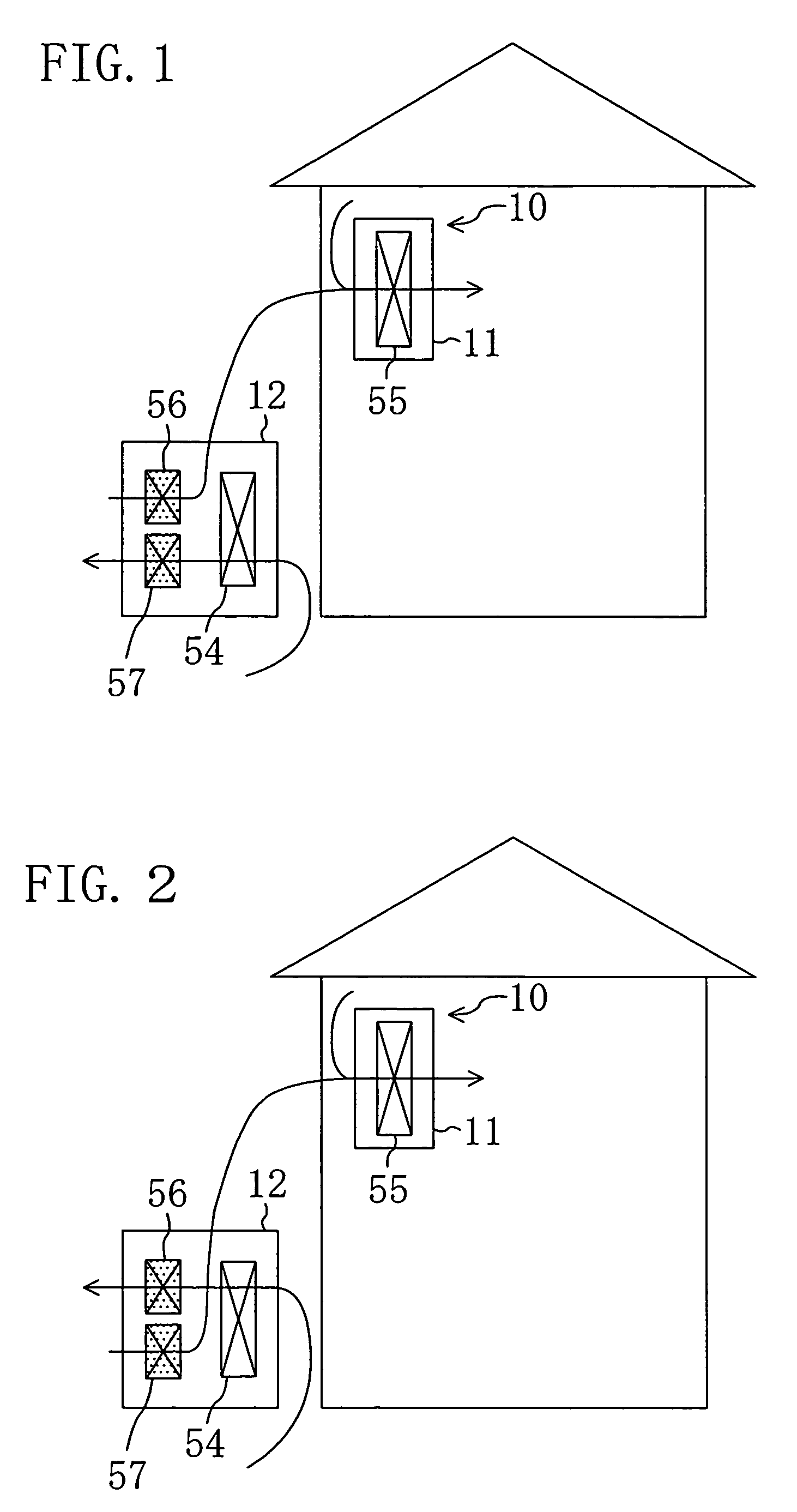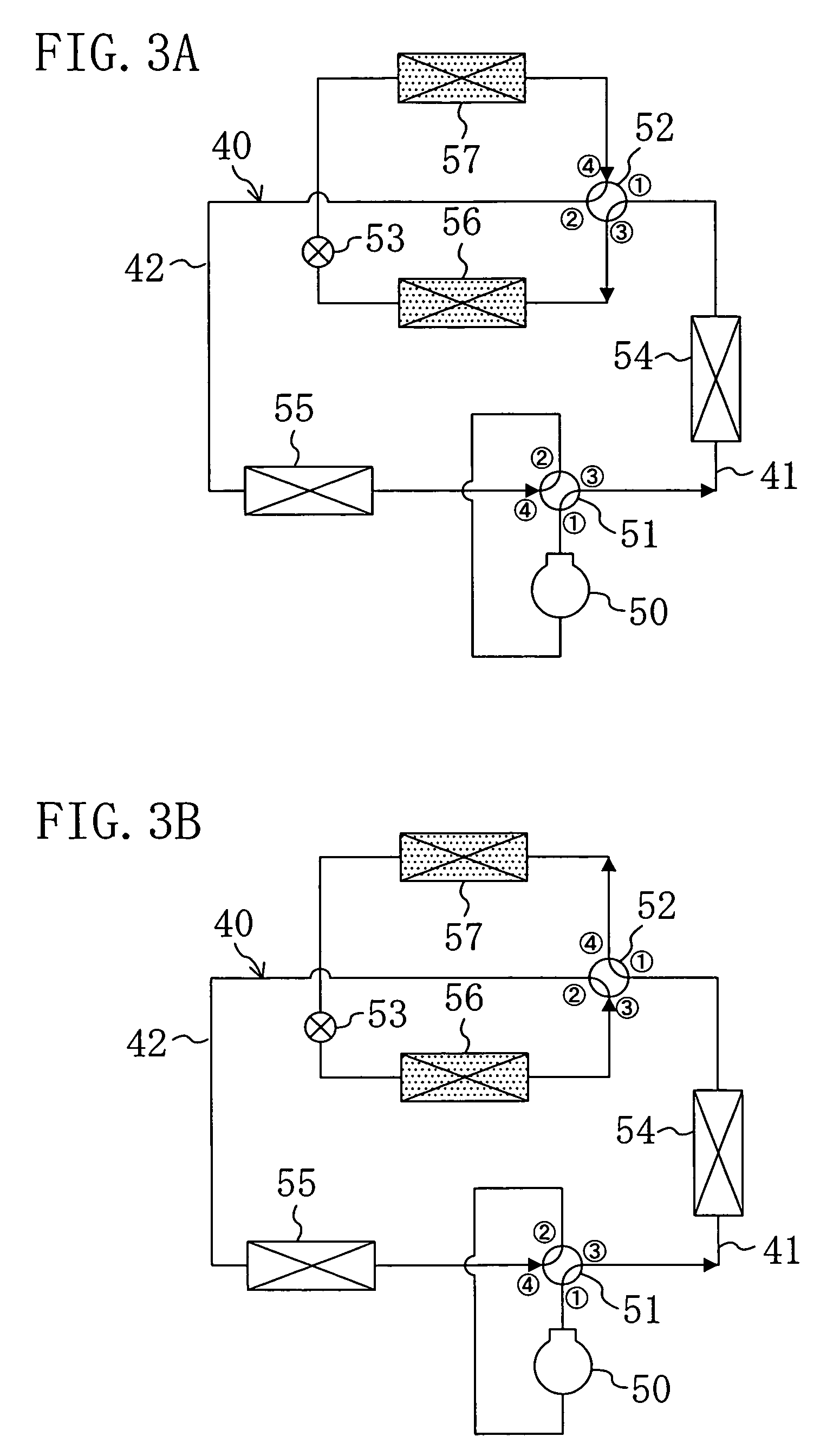Air conditioning system
- Summary
- Abstract
- Description
- Claims
- Application Information
AI Technical Summary
Benefits of technology
Problems solved by technology
Method used
Image
Examples
embodiment 1
of the Invention
[0058]Embodiment 1 of the present invention is described. An air conditioning system (10) of the present embodiment runs a vapor compression refrigeration cycle by circulating refrigerant through a refrigerant circuit (40) to cope with both of sensible heat load and latent heat load in a room space. The refrigerant circuit (40) of the air conditioning system (10) is provided with an outdoor heat exchanger (54) as a heat-source side heat exchanger, an indoor heat exchanger (55) as a utilization side heat exchanger and two adsorption heat exchangers (first and second adsorption heat exchangers) (56, 57).
[0059]As shown in FIGS. 1 and 2, the air conditioning system (10) is configured as a so-called separate type and includes an indoor unit (11) and an outdoor unit (12). The indoor unit (11) includes the indoor heat exchanger (55) and is disposed in the room space. On the other hand, the outdoor unit (12) includes the outdoor heat exchanger (54), the first adsorption heat...
embodiment 2
of the Invention
[0104]Next, Embodiment 2 of the present invention is described. As shown in FIGS. 7 and 8, the air conditioning system (10) of Embodiment 2 is configured, like Embodiment 1, as a so-called separate type and includes an indoor unit (11) and an outdoor unit (12). A refrigerant circuit (40) of the air conditioning system (10) is provided with an outdoor heat exchanger (54), an indoor heat exchanger (55) and first and second adsorption heat exchangers (56, 57).
[0105]The indoor unit (11) includes an indoor heat exchanger (55), the first adsorption heat exchanger (56) and the second adsorption heat exchanger (57) and is disposed in the room space. On the other hand, the outdoor unit (12) includes the outdoor heat exchanger (54) and is disposed in the outdoor space.
[0106]As shown in FIGS. 7 and 8, the air conditioning system (10) of Embodiment 2 is configured to allow the air to concurrently flow in parallel flows through the indoor heat exchanger (55) and the adsorption he...
embodiment 3
of the Invention
[0146]Next, an air conditioning system (10) of Embodiment 3 of the present invention is described with reference to several drawings. A refrigerant circuit (40) of the air conditioning system (10) is provided with an outdoor heat exchanger (54), an indoor heat exchanger (55) and first and second adsorption heat exchangers (56, 57). The rest of the configuration of the refrigerant circuit (40) is the same as in the above Embodiments 1 and 2 as shown in FIGS. 3 and 4.
[0147]As shown in FIGS. 11 and 12, the air conditioning system (10) is configured as a so-called separate type and includes an indoor unit (11) and an outdoor unit (12). The indoor unit (11) includes the indoor heat exchanger (55) and is disposed in a room space. The indoor unit (11) is configured as a so-called wall-mounted type, namely, is mounted on a wall surface of the room. On the other hand, the outdoor unit (12) includes the outdoor heat exchanger (54), the first adsorption heat exchanger (56) and ...
PUM
 Login to View More
Login to View More Abstract
Description
Claims
Application Information
 Login to View More
Login to View More - R&D
- Intellectual Property
- Life Sciences
- Materials
- Tech Scout
- Unparalleled Data Quality
- Higher Quality Content
- 60% Fewer Hallucinations
Browse by: Latest US Patents, China's latest patents, Technical Efficacy Thesaurus, Application Domain, Technology Topic, Popular Technical Reports.
© 2025 PatSnap. All rights reserved.Legal|Privacy policy|Modern Slavery Act Transparency Statement|Sitemap|About US| Contact US: help@patsnap.com



